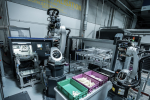New €23M BMW Additive Manufacturing Campus
German car manufacturer BMW Group has opened a $25 million (approx. €23.3 million) Additive Manufacturing Campus in Munich, expanding its effort to industrialize 3D printing for automotive production.
While the investment is new, the direction it points to has been years in the making. The company’s AM initiatives have steadily expanded since the launch of the IDAM project in 2019, which saw BMW and its partners implement two automated metal 3D printing lines; one in Bonn and one in Munich.
Three years later, BMW also helped complete the POLYLINE project, focused on developing an automated production chain for polymer parts. Both projects, backed by the German Federal Ministry of Education and Research, were aimed at moving 3D printing from prototype labs into high-throughput, factory-floor environments.
“Additive manufacturing is already an integral part of our production system,” says Milan Nedeljković, BMW AG Board Member for Production. “This new facility will enable us to further integrate and scale these technologies.”
A section of the POLYLINE project with automated systems of Grenzebach, DyeMansion and EOS, located at the Additive Manufacturing Campus of BMW. Photo via DyeMansion.
3D printing at BMW
The new campus brings many of these efforts under one roof. Around 50 3D printers have been installed at the site, with another 50 already operational across BMW’s global network. Eighty specialists are currently stationed at the Munich facility, where they’re focused on tool-less production processes with an emphasis on reducing development time and cost.
In addition to its production and prototyping roles, the campus will serve as a research and training center. BMW says it will support further development of automated workflows established through IDAM and POLYLINE, ranging from quality assurance integration to series production.
The company has also been active outside its own walls. In parallel with building its internal infrastructure, the car manufacturer has invested in startups such as Carbon, Desktop Metal (now a subsidiary of Nano Dimension), Xometry, and ELISE, with a focus on digital manufacturing, according to Design Engineering.
Other efforts to embed 3D printing deeper into manufacturing include BMW’s collaboration with Laempe Mössner Sinto, announced late last year. Through this partnership, six fully automated binder jet systems were installed at BMW’s foundry in Landshut, enabling large-scale production of sand cores for six-cylinder engine components.
Additionally, the Munich campus is expected to become a central training hub. The aim is to help employees worldwide adapt to shifting design standards, part qualification methods, and factory operations shaped increasingly by AM.
Laempe sand 3D printers. Photo via Laempe.
Automotive 3D printing facilities
Walking a similar path as BMW, other companies also invested in their own 3D printing facilities for automotive production.
One month ago, Bosch opened a €6 million metal AM facility at its Nuremberg plant, centered around a Nikon SLM Solutions NXG XII 600 3D printer. With the ability to produce up to 10,000 kg of parts per year at speeds of 1,000 cm³/h, the setup is designed to make production faster and more flexible.
By eliminating the need for tooling and reducing material waste, Bosch aims to shorten development timelines and support more sustainable practices. While initially focused on automotive components, the company also sees potential in energy and aviation applications.
Few years ago, American carmaker Ford opened an Advanced Manufacturing Center in Redford, Detroit, integrating 3D printing, collaborative robots, digital manufacturing, and augmented reality. At the time of the launch, the facility was used to produce components for the Ford Shelby Mustang GT500, including two 3D printed brackets that secured the brake line.
These parts helped reduce production costs while supporting the vehicle’s hydraulic brake system. Equipped with a 700hp 5.2-litre V8 engine, the GT500 was described as the most powerful sports car Ford had built and was showcased at the North American International Auto Show in Detroit in January 2019.
What 3D printing trends should you watch out for in 2025?
How is the future of 3D printing shaping up?
To stay up to date with the latest 3D printing news, don’t forget to subscribe to the 3D Printing Industry newsletter or follow us on Twitter, or like our page on Facebook.
While you’re here, why not subscribe to our Youtube channel? Featuring discussion, debriefs, video shorts, and webinar replays.
Featured image shows a section of the POLYLINE project with automated systems of Grenzebach, DyeMansion and EOS, located at the Additive Manufacturing Campus of BMW. Photo via DyeMansion.


